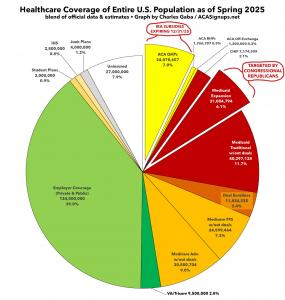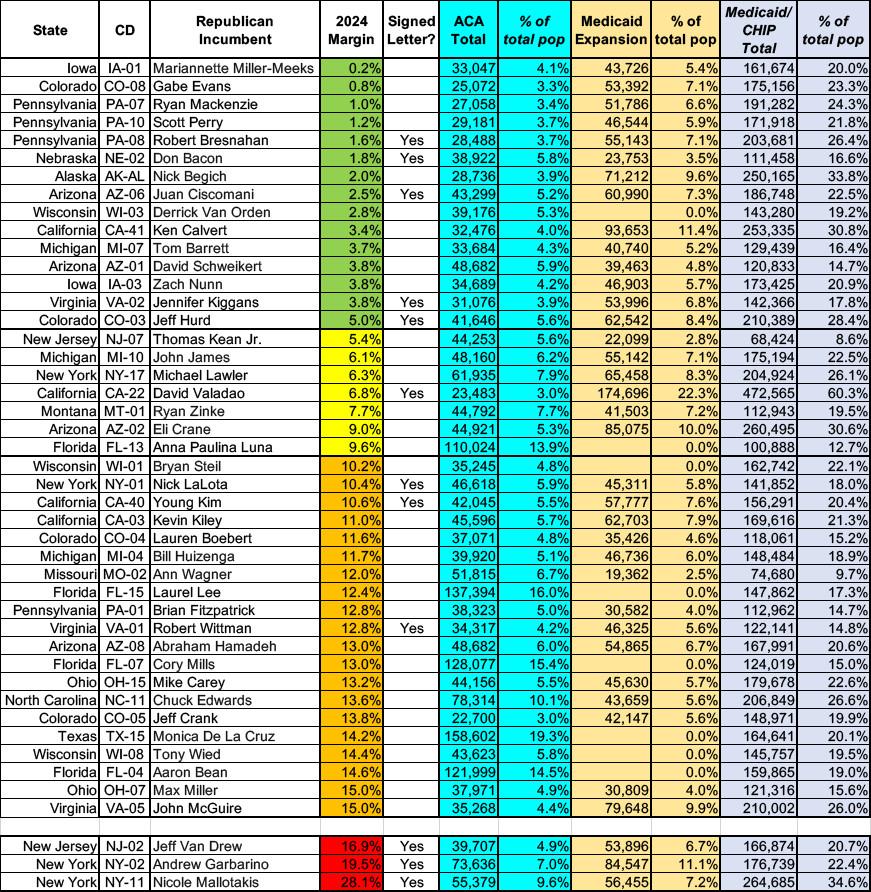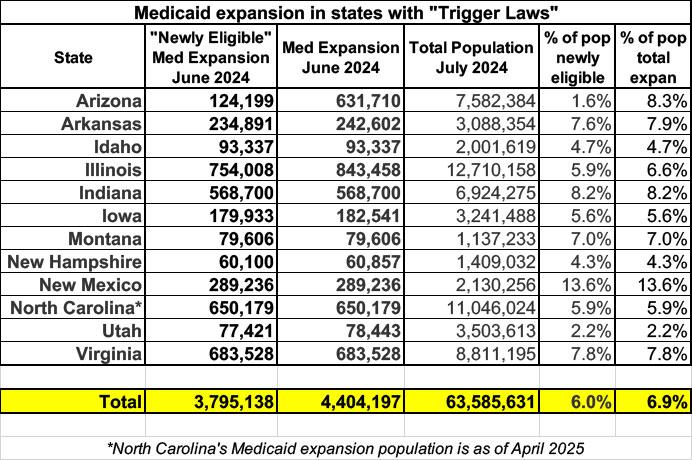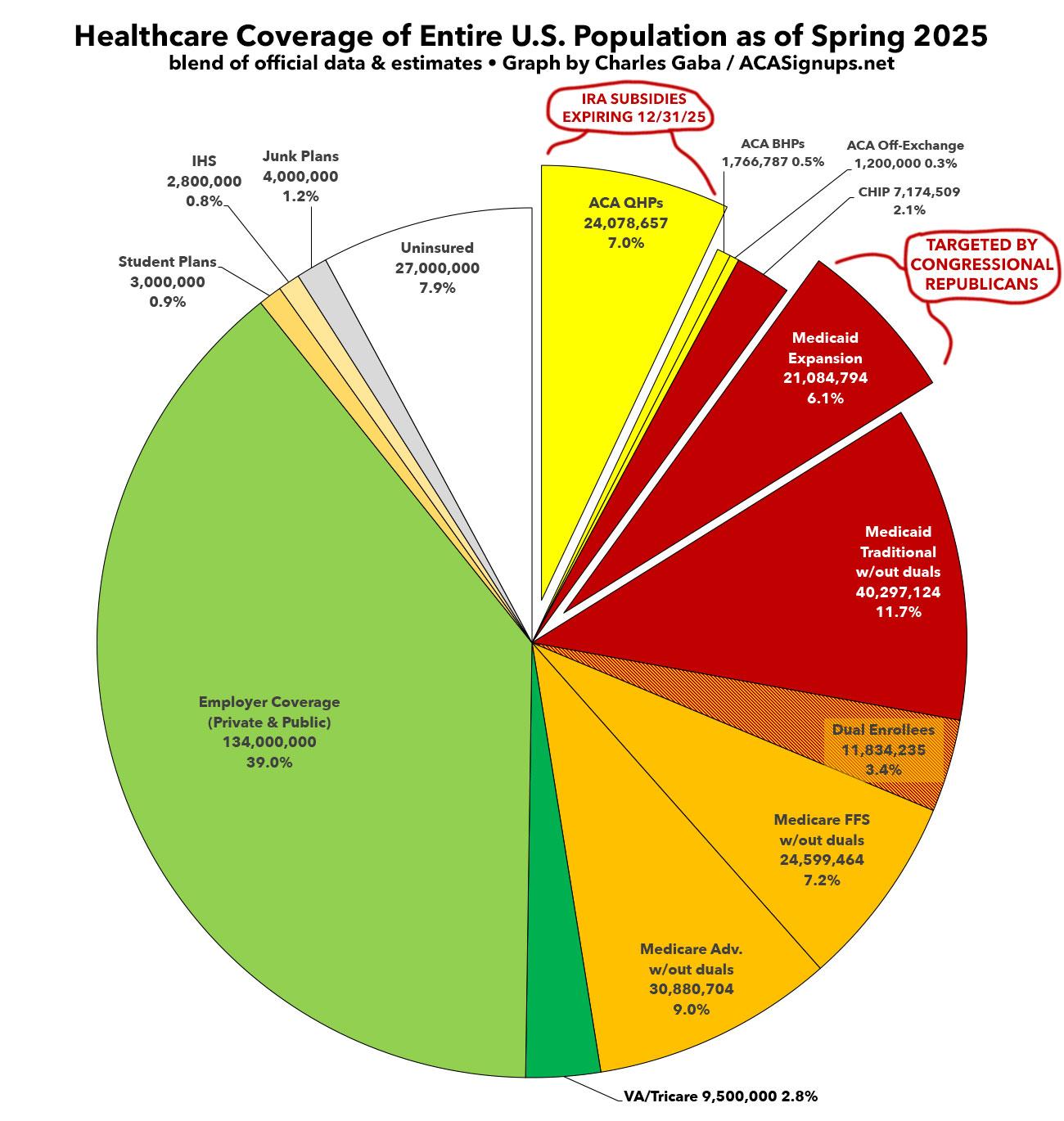Republicans have decided which 21 million Americans should lose their healthcare.

As regular readers know, I've been a bit obsessed over the past month or so with generating pie charts which break out the total healthcare program enrollment for the entire population of all 435 U.S. Congressional Districts as well as all 50 states +DC.
As you can imagine, this has been a monumental task; not only did I have to crunch a lot of data to break out the statewide numbers into House district-level estimates, I also had to convert that data into nearly 480 easy-to-read graphics...and then I doubled my workload by going one step further and adding high-res PDF versions for folks to print out in large format for town halls, rallies and #HandsOff protests nationally.
Now that I've finally completed this project, it's time to turn back to the main reason for it in the first place: The imminent threat to healthcare coverage for literally tens of millions of Americans being posed by the budget resolution recently passed by House Republicans, which (fortunately) still has a number of points where it can potentially be stopped.
The budget resolution calls for a draconian $880 BILLION to be slashed from the House Energy & Commerce Committee's jurisdiction over the next decade. While Congressional Republicans are quick to point out that technically the word "Medicaid" isn't included in the resolution itself, simple math makes it clear that there's absolutely no way to achieve that type of federal spending reduction without absolutely gutting Medicaid one way or another.
The CBO letter confirms early expectations, finding that over the next 10 years, 93% of non-Medicare spending in the E&C jurisdiction is from the federal share of Medicaid spending: $8.2 trillion out of a total $8.9 trillion. An additional $200 billion of federal spending comes from the Children’s Health Insurance Program (CHIP). Some of the committee’s remaining spending is budget-neutral, and therefore, won’t count towards deficit reduction. Even if E&C eliminated all non-Medicaid and CHIP spending, the committee would need to cut federal spending on Medicaid and CHIP by well over $700 billion, nearly 10% of projected spending; and most agree that E&C is unlikely to eliminate all other sources of non-mandatory spending.
OK, so they are indeed going after Medicaid...but how much of it and how many would lose coverage?
Well, back in January, Politico got ahold of a "wish list" of potential strategies House Republicans were tossing around to gut Medicaid and kick millions of people off of their healthcare coverage. I wrote up a breakout of these (while also relying heavily on an explainer by Edwin Park of Georgetown University):
- "REPEAL MAJOR BIDEN HEALTH RULES" ($420B): The Biden Administration put rules into place to reduce paperwork and streamline the process for eligible seniors & disabled folks to enroll in Medicaid/CHIP. House Republicans are proposing to make it more difficult for people to do so.
"Per Capita Caps" ($918B): Under the current federal-state financial partnership, the federal government pays a fixed percentage of states’ Medicaid costs, whatever those costs are. [Under a per capita cap] ...states would receive only a fixed amount of federal Medicaid funding on a per-beneficiary basis, irrespective of states’ actual costs.
"Equalize Medicaid Payments for Able Bodied Adults" - up to $690B: For non-ACA Medicaid, the federal government pays between 50 - 83% of the cost depending on the state/territory (this is known as the Federal Medical Assistance Percentage, or FMAP). For the ~21 million people enrolled in Medicaid via the ACA, the federal gov't picks up 90% of the cost. House Republicans are proposing to drop that 90% to the same 50 - 83% rates as for non-ACA Medicaid, which averages just 57% nationally.
Limit Provider Taxes - $175B: By making it more difficult for states to fund their share of Medicaid, it would force them to cut those programs entirely, which in turn would mean less federal spending on the programs. It's like telling your kid you'll pay for half their college tuition but then forbidding them to get a part-time job to cover their half.
Lower FMAP Floor - $387B: Again, right now the federal government pays anywhere between 50 - 90% of Medicaid expenses depending on the state and program. House Republicans are proposing to reduce the lower threshold from 50% to...something less than 50%. This would be devastating to the ten states which currently have a 50% FMAP rate...nine of which are blue, I should note (CA, CO, CT, MD, MA, NH, NJ, NY & WA).
Special FMAP Treatment for DC – $8B: Under the standard FMAP formula, the District of Columbia would be set at a 50% federal matching rate, down from its current 70% (I'm a little unclear as to why it's 20 points higher than it "should" be under the standard formula, and Park's explanation doesn't lend much insight).
Repeal American Rescue Plan FMAP Incentive – $18B: As I wrote about at the time, the ARPA law included one provision specifically intended to encourage the holdout states into finally expanding Medicaid by simply bribing them to do so with a generous 2-year FMAP boost for doing so. This was a critical factor in North Carolina's decision to expand Medicaid to over 600,000 low-income residents.
Work (Reporting) Requirements - $120B: (Sigh) Work reporting requirements have been an obsession of Republicans for decades. I've written about how absurdly (and deliberately) inefficient and pointless they are countless times.
There were several other healthcare-related bullets as well which mostly focus on the ACA's individual market exchange plan subsidies. I'll be writing about those separately soon, but for the moment I'm sticking with Medicaid.
As you can imagine, there's been a loud and growing backlash against Congressional Republicans in response to their proposed gutting of Medicaid & other critical programs...a backlash which my own pie chart project has been a part of, I'm proud to say.
(Sidebar: Here's U.S. Rep. Maxwell Frost & U.S. Sen. Chris Murphy holding up & talking about one of my charts...in this case it's the one for MI-10, where GOP Rep. John James abandoned his district months ago ahead of his 3rd attempt at a statewide win, this time for Governor):
There are 42 House Republicans who won their seats last November by 15 points or less. Meanwhile, Democrats have been outperforming their districts by an average of over ten points in special elections so far this year.
Combine these data points with the growing backlash and as you can imagine, some House Republicans in swing districts (and not-normally-considered swing districts) are understandably nervous about ripping healthcare coverage away from up to 60% of their constituents (that's not a typo...check out CA-22).
Update: Here's all 42 of those House Republicans who won by 15 points or less, along with the estimated ACA, Medicaid expansion & total Medicaid/CHIP enrollment in each of their districts:
The optics look even worse for Republicans when Democrats have been successfully calling attention to the huge numbers of children, the elderly and the disabled who rely on Medicaid, as noted by my friend & colleague Andrew Sprung:
Here is the core defense in a letter from Families USA, co-signed by more than 300 advocacy groups, to Senate Majority Leader John Thune, asking him to reject the house budget resolution:
Medicaid is a lifeline for communities across the country. It provides affordable health insurance to almost 80 million Americans—1 in 5 people living in the United States—and serves as a financial backbone of the health care system, including for the clinics and hospitals on which we all rely. Medicaid delivers essential care to 37 million children, 14 million people living in rural areas and more than 8 million people with disabilities. It supports 7 million seniors and 12 million Medicare enrollees. It also covers more than 40 percent of all births and is the single largest payer to community clinics, for long-term care, and for mental health and substance use disorder services in the country.
So, what's a Republican House member to do? They have to have their massive tax cuts for millionaires & billionaires, after all; that's not even up for debate in their minds!
Well, as Sprung goes on to note, the very advocacy for these vulnerable groups of Americans has also provided the "solution" to Republicans' problem in their eyes:
Republicans are out there proclaiming that “able-bodied” adults don’t deserve coverage, that the 90% federal match rate for the expansion that made it financially viable for states sucks resources from “traditional” Medicaid beneficiaries (it doesn’t), that defunding the expansion is just cutting “waste, fraud, and abuse” — that is, that low-income adults without affordable access to employer insurance are effectively human waste. The copious benefits to expansion beneficiaries themselves and to state healthcare systems and finances stemming from the expansion need to be defended directly.
Sure enough, just a couple of days ago, Punchbowl News reported that:
A dozen House Republicans are warning GOP leaders that they won’t back a reconciliation package that includes massive cuts to Medicaid, according to a letter first obtained by Punchbowl News.
(Sidenote: Punchbowl doesn't appear to understand just how "massive" the cuts to Medicaid these dozen House Republicans are OK with would be, as I'll explain below).
...“We support targeted reforms to improve program integrity, reduce improper payments, and modernize delivery systems to fix flaws in the program that divert resources away from children, seniors, individuals with disabilities, and pregnant women — those who the program was intended to help.
“However, we cannot and will not support a final reconciliation bill that includes any reduction in Medicaid coverage for vulnerable populations.”
...“There’s reasonable actions we can support like work requirements for able bodied adults without children and auditing the Medicaid list,” Bacon told us. “But there will not be the votes to cut Medicaid for those who need it or to the hospitals that we need to preserve.”
Kim said in a statement that a reconciliation package “that does not protect vital Medicaid services for the most vulnerable citizens in my community will not receive my vote,” adding she’s made that clear to constituents and GOP leadership.
...Van Drew later told reporters that Johnson promised not to cut Medicaid for individuals who are “qualified” to receive the benefit. LaLota told us that the speaker vowed to take a “compassionate approach.”
In other words, of the 8 ideas House Republicans were playing around with back in January, it sounds an awful lot like they're gonna boil it down to two: Reducing the FMAP matching rate and imposing work reporting requirements for the ACA expansion population...while presumably "showing mercy" on the the non-expansion population.
As Jason Sattler aka LOLGOP notes (and as I alluded to above), the way Punchbowl frames this makes it sound like these dozen Republicans are to be praised for "only" tearing away healthcare coverage from up to 21 million people who are "undeserving" of it for some reason or another.
This is the same type of "logic" which the Trump Regime has been using in trying to justify denying due process to people who they (falsely in most cases) have accused of being "gang members" and which Republicans writ large have been using to justify kidnapping & imprisoning people in a foreign gulag because they "aren't U.S. citizens." As if only U.S. citizens are "entitled" to be treated as...well, as human beings. (And of course they've been kidnapping some U.S. citizens as well, I should note).
In short, the talking point that Congressional Republicans have settled on is to go after ACA Medicaid expansion specifically.
Jonathan Cohn of The Bulwark concurs:
Then Johnson went on Fox and, after the obligatory promise “to protect Medicare, Social Security, Medicaid for people who are legally beneficiaries of those programs,” said the following:
We have to root out fraud, waste, and abuse. We have to eliminate people on, for example, on Medicaid who are not actually eligible to be there—able-bodied workers, for example, young men who are—who should never be on the program at all.
When you have people on the program that are draining the resources, it takes it away from the people that are actually needing it the most and are intended to receive it. You’re talking about young, single mothers, down on their fortunes at a moment—the people with real disabilities, the elderly. And we’ve got to protect and preserve that program. So we’re going to preserve the integrity of it.
That may sound like a defense of Medicaid and the people who need it, and surely that’s how Johnson hopes the public will interpret it. But that is also the language Medicaid critics have been using to describe a big, controversial downsizing of the program—one that would undermine what was arguably Obamacare’s single biggest achievement.
So, what would actually happen if "all" they end up doing was reducing the the percent of Medicaid costs which are paid by the federal government for the expansion population from 90% down to whatever the non-expansion FMAP rate is for each state?
Twelve states currently have “trigger” laws in place that would automatically end expansion or require changes if the federal match rate were to drop, but coverage would be at risk in other states given the substantial loss of federal funding. Not all trigger laws would immediately end the Medicaid expansion, but enrollees in states with trigger laws are at greater risk of losing coverage. States are actively debating their Medicaid expansion trigger laws, with some states working to remove and others working to establish the automatic termination of Medicaid expansion coverage if federal support declines.
Here's the 12 states with trigger laws. Barring legislation by the individual states, between 3.8*- 4.4 million Americans would be kicked off of Medicaid from these states right out of the gate...up to 13.6% of their entire populations. It's worth noting that one of these is North Carolina, which just implemented Medicaid expansion a little over a year ago.
Update*: I forgot that about 18% of those enrolled in Medicaid via ACA expansion were actually already legally eligible to enroll before the ACA was passed, and presumably still would be if ACA expansion ended in their state; the other ~82% are only or newly eligible specifically via ACA expansion. I've updated the table below to reflect this.
The second immediate consequence would be that the 10 remaining non-expansion states (AL, KS, MS, FL, GA, SC, TN, TX, WI & WY), where over 1.4 million low-income adults have been caught in the "Medicaid gap" for over a decade now would absolutely never expand their programs.
OK, but what about the 16.6 million Medicaid expansion enrollees in the other 19 states which did expand Medicaid?
Well, according to this analysis by KFF, here's how much every expansion state (including the 12 w/trigger laws) would have to come up with on their own in order to fill in the $626 BILLION in lost federal funding if they wanted to keep their current expansion populations covered:
These estimates are for a ten year period, but even so, not many states have several hundred million dollars in extra cash lying around each year (or several billion per year in the case of the larger states). A few of the deeper blue states might find some way to cover the lost funds, but it would only be a fraction of what's needed, and my guess is most won't even bother to try.
Update: Nationally, of the ~21 million enrolled in Medicaid via ACA expansion, around 3.6 million were already eligible and would theoretically be able to stay on their state's non-ACA Medicaid program, bringing the number of Americans losing coverage in the event of every state dropping expansion down to perhaps 17.6 million.
On the other hand, this would still cause an increased strain on the budgets of those states which would likely lead to reduced services for their remaining Medicaid populations.
The "beauty" of this from a sociopathic MAGA Republican point of view is that a) none of the Republicans representing the 10 non-expansion states would have to sweat it, since they never expanded their programs in the first place; and b) since technically there's nothing in the legislation which actually reduces Medicaid eligibility for any specific population, they get to (try to) shift the blame to the states for not coming up with the extra funds necessary to keep the program running.
This post is getting pretty lengthy, so I'll address the "work reporting requirement" scheme (as well as the looming expiration of the ACA's IRA subsidies) separately, but in the meantime, here's what targeting the ACA Medicaid expansion portion of the population looks like nationally.
(Note: This is a revised/simplified version of my "Psychedelic Donut" breakout; the estimates for some categories are rounded off to the nearest million for simplicities sake.)
How to support my healthcare wonkery:
1. Donate via ActBlue or PayPal
2. Subscribe via Substack.
3. Subscribe via Patreon.








